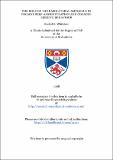Files in this item
The role of the basolateral amygdala in cocaine self-administration and cocaine-seeking behaviour
Item metadata
| dc.contributor.advisor | Winn, Philip | |
| dc.contributor.author | Whitelaw, Rachel B. | |
| dc.coverage.spatial | 240 p. | en_US |
| dc.date.accessioned | 2018-06-29T10:15:09Z | |
| dc.date.available | 2018-06-29T10:15:09Z | |
| dc.date.issued | 1998 | |
| dc.identifier.uri | https://hdl.handle.net/10023/14741 | |
| dc.description.abstract | The experiments reported in this thesis have investigated the role of the basolateral amygdala (BLA) in the process by which conditioned stimuli (CS) acquire motivational salience and, as conditioned reinforcers, direct cocaine-seeking behaviour in the rat. Excitotoxic lesions of the BLA did not interfere with the reinforcing effects of cocaine in rats. Intra-peritoneal injections of cocaine produced similar locomotor responses in both lesioned and control animals and both groups also produced equivalent dose-response functions during a within- session dose-response test. Similarly, lesioned and control animals acquired cocaine self-administration under both continuous and progressive-ratio schedules of reinforcement. However, BLA-lesioned animals were (i) severely impaired in the acquisition of second-order schedules of cocaine self-administration; (ii) more sensitive than control animals to reductions in drug dose under a progressive-ratio schedule of cocaine self-administration and (iii) less sensitive than control animals to the omission of a drug-related CS, under a fixed-interval schedule of selfadministration. In vivo microdialysis showed that lesions of the BLA were associated with an impaired glutamatergic response to intra-nucleus accumbens infusions of cocaine, but that the dopaminergic response of lesioned and control animals of were identical. These findings suggest that drug-seeking behaviour in rats with lesions of the BLA is influenced more by the primary reinforcer and concomitantly less by secondary, conditioned reinforcers. This would indicate that the BLA is significantly involved in the development of cue-elicited drug-seeking behaviour and, by inference, this structure may also play an important role in the development of problem drug-use in humans. | en_US |
| dc.language.iso | en | en_US |
| dc.publisher | University of St Andrews | |
| dc.subject.lcc | QP376.W5 | |
| dc.subject.lcsh | Brain--Juvenile literature | en |
| dc.title | The role of the basolateral amygdala in cocaine self-administration and cocaine-seeking behaviour | en_US |
| dc.type | Thesis | en_US |
| dc.type.qualificationlevel | Doctoral | en_US |
| dc.type.qualificationname | PhD Doctor of Philosophy | en_US |
| dc.publisher.institution | The University of St Andrews | en_US |
This item appears in the following Collection(s)
Items in the St Andrews Research Repository are protected by copyright, with all rights reserved, unless otherwise indicated.

